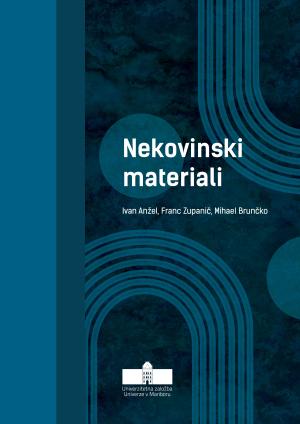Nekovinski materiali
Ključne besede:
nekovinski materiali, polimeri, keramika, kompoziti, zgradba, lastnostiKratka vsebina
V skripti Nekovinska gradiva bodo študenti spoznali ključne vidike pomena nekovinskih materialov v sodobnem inženirstvu. Ti materiali so danes v številnih panogah postali nepogrešljivi pri načrtovanju in izdelavi izdelkov, v nekaterih primerih pa že povsem nadomeščajo kovine in zlitine. Kombinacija njihovih edinstvenih lastnosti omogoča razvoj tehnološko naprednih rešitev, ki so hkrati energetsko učinkovite in prijazne do okolja. S študijskim gradivom Nekovinski materiali bodo študenti pridobili poglobljeno razumevanje o zgradbi, lastnostih in tehnologijah izdelave polimernih, keramičnih in kompozitnih materialov.
Prenosi
Literatura
[1] N. J. Mills: Plastics – Microstructure, Properties and Applications, Edward Arnold Ltd, London, 1986.
[2] I. Anžel, M. Brunčko, F. Zupanič, Sodobni inženirski materiali, Univerza v Mariboru, 2025.
[3] Georg Menges: Werkstoffkunde – Kunststoffe, 3. Auflage, Carl Hansen Verlag, München, Dunaj, 1990.
[4] Adolf Echte: Handbuch der Technischen Polimerchemie, VCH Verlagsgesellschaft mbH, Weinheim, New York, Basel, Cambridge, Tokio, 1993.
[5] Bernd-Joachim Jungnickel und 5 Mitautoren: Umformen von Kunststoffen im festen Zustand, Expert Verlag, 1988.
[6] M. F. Ashby: Materials Selection in Mechanical Design, Third Edition, Butterworth-Heinemann, Oxford, 2004.
[7] W. D. Callister: Materials Science and Engineering – an Introduction, 5th editon, John Wiley & Sons, Inc., 2000.
[8] R. J. Young, P. A. Lovell: Introduction to Polymers, 3rd edition, CRC Press, Boca Raton, 2011.
[9] J. M. G. Cowie, V. Arrighi: Polymers: Chemistry and Physics of Modern Materials, 3rd edition, CRC Press, Boca Raton, 2007.
[10] Ullmann's Encyclopedia, Ullmann's Polymers and Plastics, Wiley-VCH, 7th edition, Weinheim, 2016.
[11] D. Kyriacos, High-Temperature Engineering Thermoplastics, Brydson's Plastics Materials, 21, Elsevier, 2017, str. 545‒615.
[12] V. R. Sastri, Fillers (Including Fibers Reinforcements), Plastics in Medical Devices, 8, Elsevier, 2014.
[13] M. Žigon, Uvod v polimere, Ljubljana, 2009.
[14] R. E. Cameron, A. Kamvari-Moghaddam: Synthetic bioresorbable polymers, Cambrige, Woodhead Publishing Limited, 2012, str. 96‒118.
[15] F. Sarasini: Biocomposites for High-Performance Applications, Rim, Elsevier, 2017, str. 82‒123.
[16] S. Pilla: Handbook of Bioplastics and Biocomposites Engineering Applications, New Jersey, John Wiley & Sons, 2011.
[17] Michel Barsoum: Fundamentals of ceramics, McGraw-Hill, 1997.
[18] Drago Kolar: Tehnična keramika, I. in II. knjiga, Zavod Republike Slovenije za šolstvo in šport, 1993.
[19] W. E. Worrall: Clays and ceramic raw materials, 2th edition, Elsevier 1986.
[20] P. W. Atkins: Physical Chemistry, 4th edition, Oxford University Press, New York, 1990.
[21] D. W. Richerson: Modern ceramic engineering, Dekker, New York, 1982.
[22] J. E. Reed: Introduction to the principles of ceramic processing, Wiley, New York, 1988.
[23] G. Y. Onoda, L. L. Hench: Ceramic processing before firing, Wiley, New York, 1978.
[24] R. J. Borg, G. D. Dienes: The Physical Chemistry of Solids, Academic Press, New York, 1992.
[25] E. Krause, I. Berger, O. Krockel, P. Maier: Technologie der Keramik, B. 3, Thermische Prozesse, VEB Verlag für Bauwesen Berlin, 1985.
[26] J. Reed: Principles of Ceramic Processing, 2d edition, Wiley, New York, 1995.
[27] T. H. Courtney: Mechanical Behavior of Materials, McGraw-Hill, New York, 1990.
[28] A. Kelly, N. H. Macmillan: Strong Solids, 3d edition, Clarendon Press, Oxford, Anglija, 1986.
[29] R. W. Davidge: Mechanical Behavior of Ceramics, Cambridge University Press, New York, 1979.
[30] J. R. Taylor, A. C. Bull: Ceramics Glaze Technology, Pergamon Oxford, 1986.
[31] H. W. Chandler: Thermal Stresses in Ceramics, Trans. J. Brit. Cer. Soc. 191, 1981.
[32] A. J. Moulson, J. M. Herbert: Electroceramics, Chapman & Hall, London 1992.
[33] W. Krenkel: Ceramic matrix composites, Wiley-VCH, 7th edition, Weinheim, 2008.
[34] K. K. Chawla: Ceramic matrix composites, 2nd edition, Springer US, New York, 2003.
[35] H. Oettel, H. Schumann, Metallografie, 15. Auflage, Wiley-VCH Verlag, Wienheim, 2011.
[36] L. Kosec: Kompoziti, KZT, letnik 28, št. 1‒2, str. 19‒24, 1994.
[37] N. J. Mills: Plastics – Microstructure, Properties and Applications, Edward Arnold Ltd, London, 1986.
[38] G. Lojen: Sinteza tiksotropnih mešanic, doktorska disertacija, Fakulteta za strojništvo, Univerza v Mariboru, Maribor, 2002.
[39] W. F. Smith: Principles of Materials Science and Engineering, McGraw-HillBook Company, New York, 1986.
[40] I. Anžel: Notranja oksidacija hitro strjenih bakrovih zlitin, Naravoslovnotehniška fakulteta, Univerza v Ljubljani, Ljubljana, 1996.
[41] R. Rudolf, A. Križman: Analiza mikrostrukture kompozitov AlSi7-SiC, izdelanih po postopku tiksotropnega ulivanja, KZT, letnik 32, št. 3/4, 1998.
[42] M. Flemming, G. Ziegmann, S. Roth: Faserverbundbauweisen, Springer-Verlag, Berlin, Heidelberg, 1995.
[43] M. Taya, R. J. Arsenault: Metal Matrix Composites, Pergamon Press, Oxford, New York, 1989.
[44] R. W. Cahn, P. Haasen: Physical Metallurgy Part I, Part II, North-Holland-Physics Publishing, Amsterdam, Oxford, New York, Tokio, 1983.
[45] R. A. Flinn, P. K. Trojan: Engineering Materials and their Applications, John Wiley&Sons, 4th edition, 1995.
[46] B. Terry, G. Jones: Metal Matrix Composites, Elsevier Science Publishers Ltd. 1994.
[47] O. Schwarz: Kunststoffkunde, Vogel Buchverlag 2. Auflage, Wurzburg, 1987.
[48] T. W. Clyne, D. Hull, An Introduction to Composite Materials, Third Edition, Cambridge University Press, 2019.







